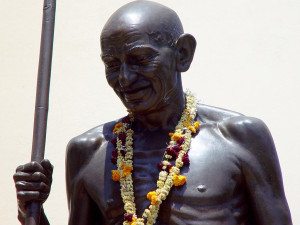
An example of a self-goverened commons: Wikipedia. Copyright: wikipedia, licensed under a creative commons share alike license, see www.wikipedia.org
It is rare these days to see high-level government thinkers talk about the commons. Here is one: Arun Maira of Indias Planning Commission makes the point that commons-based models are important tools to plan for the future of democracy worldwide.
Here is the summary: “The world is full of complex problems, but humanity’s main organizational tools — governments and markets — leave much to be desired. Arun Maira, a member of India’s Planning Commission and previously the chairman of Boston Consulting Group in India, points to a third way.”

Statue of Gandhij in Baroda, now called Vadodara, Ghandi, in my view, was one of the inventors of the “commons” for a common good. / Picture by Brian Glanz / Licenced under CC Attribution 2.0 Generic (CC BY 2.0) / Source: https://www.flickr.com/photos/brianglanz/2767070246/
I like his focus on “Four L’s” — localization, lateralization, learning and listening, and of course his praise of Ostrom. My only criticism is, that the piece is not dwelling enough on the issue of “knowledge as a commons”, but that may be the next topic of the Indian planning commission …
And here’s the full piece.
____
Note: This text was first published on the blog of Balthas Seibold at the Alumniportal Germany (www.alumniportal-deutschland.org/en/). Check the blog ( register or login first). All blog entries represent the personal views and ideas of Balthas Seibold.